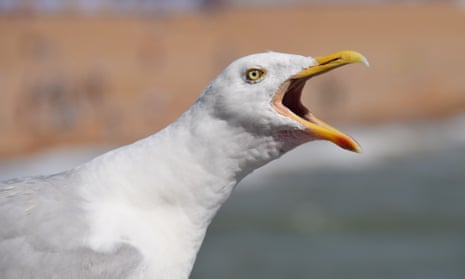It’s not just your chips that are threatened by seagulls at the British seaside: increasingly, the gull menace is hitting taxpayers in their pockets too, as research shows local councils are spending hundreds of thousands trying to control the birds.
Waste management practices are partly to blame, as less frequent collection of bins gives the scavengers plenty of access to free meals, in turn encouraging them into urban areas. The problem has escalated in the last 15 years, according to Sarah Trotter, an assistant professor of law at the London School of Economics, who has written two papers on the subject. The birds have been blamed for attacking pets and people in towns all around the UK’s coastline, and sometimes even inland.
Trotter cites the example of Dumfries and Galloway in Scotland, which spent £263,000 between 2009 and 2016 on control measures for the gulls. Aberdeen spent £27,000 in 2015-16, down from nearly £90,000 a few years previously. Even less-affected councils have been spending £10,000 a year, often with little to show for their efforts. There are no publicly available national figures for how much is spent on the problem, but a sample of several councils suggests the sums may run into hundreds of thousands a year across the country, and in a few years can quickly add up to a drain on scarce resources in seaside towns.
Perhaps even worse is the disruption caused by the birds, and not only to tourism. Trotter cites cases where gulls have caused delays to postal deliveries and provoked residents into prowling the streets with guns to kill the birds, and where droppings have caused a hazard to pedestrians by making footpaths slippery. In one case in Aberdeen, a particularly troublesome seagull was described as being “the size of a large dog”.
In 2015 the “seagull wars” centred on Cornwall, with reports of children, older people and pets being injured as they fell prey to aggressive gulls. The then chancellor, George Osborne, scuppered a planned £250,000 study into the problem.
Councils have responded by using plastic owls and real birds of prey to scare away the gulls; by removing nests, eggs and, in some cases, chicks; and by replacing real eggs with imitation eggs, or even oiling eggs to prevent them from hatching.
While the killing of other wild birds has caused outrage and controversy in recent weeks, seagulls – despite Britain’s seven main species being listed as of concern in conservation terms – have few admirers. A YouGov poll in 2015 found seagulls to be Britain’s least loved birds, with 44% of people supporting a cull. Trotter reports that in her research she saw little backlash against the control measures. “I did not encounter much opposition – they really are not liked,” she told the Guardian. “We have shifted our thinking to see them not as part of nature but as urban pests.”
Measures that Trotter suggests can help include public awareness campaigns, and better measures to prevent littering.
A spokesperson for the Local Government Association said: “Councils are doing everything they can to stop seagulls from disturbing residents and visitors. This includes using stronger refuse bags, replacing eggs with dummy replicas, painting buildings colours that deter gulls and even using specially-bred birds of prey. The increased nuisance from seagulls is partly linked to discarded takeaways and so residents are being urged to help by making sure they properly dispose of food eaten in public places.”
The modern image of aggressive gulls swooping down to snatch ice creams from unsuspecting daytrippers contrasts strongly with more traditional perceptions of the birds. In her new papers, Trotter shows the bold behaviour of gulls was discussed in parliament in the 1860s, when a seabird preservation law was enacted, partly on the grounds that the birds provided a valuable guide to sailors and fishermen and gobbled up farmland pests.









